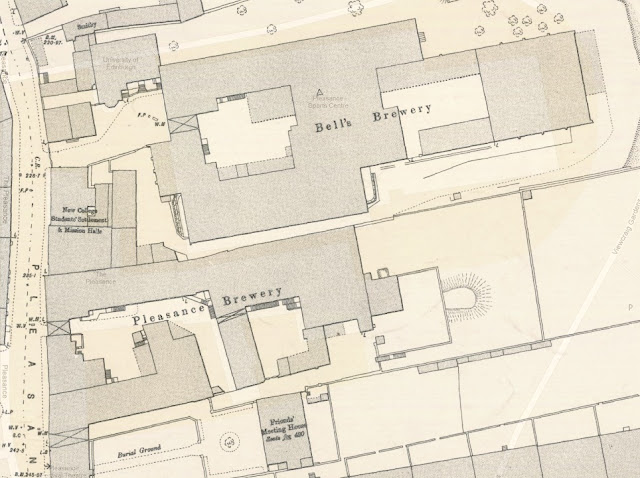Monday, 7 May 2012
Edinburgh United Breweries
Scottish breweries with an unusual fate. That seems to be a new theme of mine. This one is even odder than Pattisons. As with so many of these stories, at first everything looked not just fine, but wonderful for Edinburgh United Breweries. It would end with several employees in jail.
Odd, given its ignominious demise, that one of the company's products should still be remembered: Disher's Ten Guinea Ale. The strongest draught beer I've found an analysis for. Maybe that explains why it's been remembered. Though after a couple of pints of this 10% ABV monster, I doubt you'd remember anything at all.
Edinburgh United Breweries was formed in 1889 by the merger of four old Edinburgh firms:
Robert Disher (The Edinburgh & Leith Brewery)
Robin, McMillan & Co (The Summerhall Brewery)
D. Nicolson & Sons (The Palace Brewery)
George Ritchie (Bells Brewery)
Robert Disher, the Palace Brewery, Bells Brewery and Summerhall Brewery. Combined, they formed the third largest brewery in Scotland*. A sure formula for raking in the dosh, you would have thought. Especially as they were quick to become a public company. But things are rarely that simple.
In the late 1880's and early 1890's, investors loved brewery and distillery flotations. They were usually massively over-subscribed. Doubtless they were spurred on by the highly successful and profitable launches of companies like William McEwan and Guinness. Their profits were large and investors were richly rewarded for their capital.
It didn't work out like that in this case. Even in the fat years of the 1890's, the company struggled to make much of a profit. Perhaps keeping all the breweries open wasn't the smartest move. Summerhall was the first to go, closing in 1911**. Disher's and the Palace Brewery followed in 1916***.
As you can see from this 1893 map, Disher's was a reasonable size by Edinburgh standards. It was just a few alleyways further down Canongate than William Younger's Holyrood Brewery. In the part of Edinburgh that was stuffed with breweries at the end of the 19th century.
Bells Brewery wasn't far away, at 48 the Pleasance. It looks a little smaller than Disher's, though the site wasn't as hemmed in:
Remember this brewery. It's where the criminal activity took place. But you'll have to wait a while to discover the full details of that.
* "Scottish Brewing Archive Journal Vol. 11 Autumn/Winter 2011", page 20.
** "A Century of British Brewers", by Norman Barber, 2005, page 91.
*** "Scottish Brewing Archive Journal Vol. 11 Autumn/Winter 2011", page 20.
Odd, given its ignominious demise, that one of the company's products should still be remembered: Disher's Ten Guinea Ale. The strongest draught beer I've found an analysis for. Maybe that explains why it's been remembered. Though after a couple of pints of this 10% ABV monster, I doubt you'd remember anything at all.
Edinburgh United Breweries was formed in 1889 by the merger of four old Edinburgh firms:
Robert Disher (The Edinburgh & Leith Brewery)
Robin, McMillan & Co (The Summerhall Brewery)
D. Nicolson & Sons (The Palace Brewery)
George Ritchie (Bells Brewery)
Robert Disher, the Palace Brewery, Bells Brewery and Summerhall Brewery. Combined, they formed the third largest brewery in Scotland*. A sure formula for raking in the dosh, you would have thought. Especially as they were quick to become a public company. But things are rarely that simple.
In the late 1880's and early 1890's, investors loved brewery and distillery flotations. They were usually massively over-subscribed. Doubtless they were spurred on by the highly successful and profitable launches of companies like William McEwan and Guinness. Their profits were large and investors were richly rewarded for their capital.
It didn't work out like that in this case. Even in the fat years of the 1890's, the company struggled to make much of a profit. Perhaps keeping all the breweries open wasn't the smartest move. Summerhall was the first to go, closing in 1911**. Disher's and the Palace Brewery followed in 1916***.
As you can see from this 1893 map, Disher's was a reasonable size by Edinburgh standards. It was just a few alleyways further down Canongate than William Younger's Holyrood Brewery. In the part of Edinburgh that was stuffed with breweries at the end of the 19th century.
Bells Brewery wasn't far away, at 48 the Pleasance. It looks a little smaller than Disher's, though the site wasn't as hemmed in:
Remember this brewery. It's where the criminal activity took place. But you'll have to wait a while to discover the full details of that.
* "Scottish Brewing Archive Journal Vol. 11 Autumn/Winter 2011", page 20.
** "A Century of British Brewers", by Norman Barber, 2005, page 91.
*** "Scottish Brewing Archive Journal Vol. 11 Autumn/Winter 2011", page 20.
Subscribe to:
Post Comments (Atom)












































































No comments:
Post a Comment